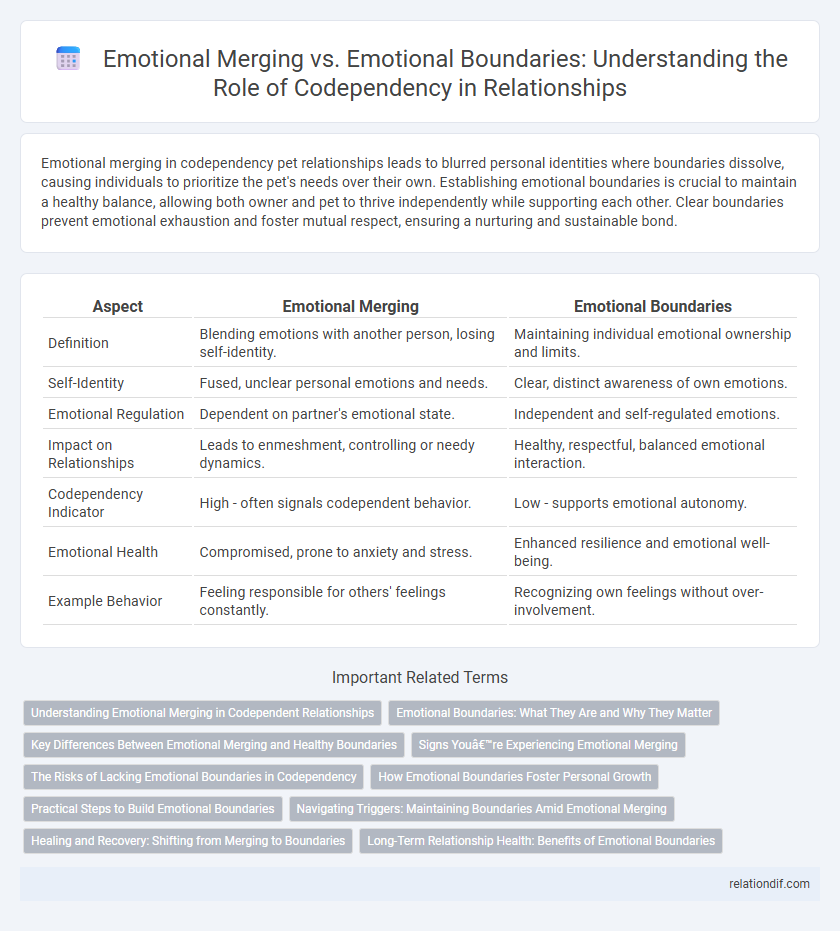Emotional merging in codependency pet relationships leads to blurred personal identities where boundaries dissolve, causing individuals to prioritize the pet's needs over their own. Establishing emotional boundaries is crucial to maintain a healthy balance, allowing both owner and pet to thrive independently while supporting each other. Clear boundaries prevent emotional exhaustion and foster mutual respect, ensuring a nurturing and sustainable bond.
Table of Comparison
| Aspect | Emotional Merging | Emotional Boundaries |
|---|---|---|
| Definition | Blending emotions with another person, losing self-identity. | Maintaining individual emotional ownership and limits. |
| Self-Identity | Fused, unclear personal emotions and needs. | Clear, distinct awareness of own emotions. |
| Emotional Regulation | Dependent on partner's emotional state. | Independent and self-regulated emotions. |
| Impact on Relationships | Leads to enmeshment, controlling or needy dynamics. | Healthy, respectful, balanced emotional interaction. |
| Codependency Indicator | High - often signals codependent behavior. | Low - supports emotional autonomy. |
| Emotional Health | Compromised, prone to anxiety and stress. | Enhanced resilience and emotional well-being. |
| Example Behavior | Feeling responsible for others' feelings constantly. | Recognizing own feelings without over-involvement. |
Understanding Emotional Merging in Codependent Relationships
Emotional merging in codependent relationships occurs when individuals lose their sense of self by excessively identifying with their partner's feelings and needs, leading to blurred emotional boundaries. This dynamic impairs personal autonomy and fosters dependency, making it difficult to distinguish between one's own emotions and those of the partner. Establishing clear emotional boundaries is essential to breaking this cycle and promoting healthier, more balanced relationships.
Emotional Boundaries: What They Are and Why They Matter
Emotional boundaries are crucial for maintaining individual identity and mental health in relationships, serving as invisible lines that separate one person's feelings and needs from another's. They prevent emotional merging, a hallmark of codependency, where individuals lose their sense of self by over-identifying with others' emotions and problems. Establishing clear emotional boundaries fosters healthy interdependence, promoting personal growth and balanced, respectful connections.
Key Differences Between Emotional Merging and Healthy Boundaries
Emotional merging involves losing individual identity by excessively absorbing another person's feelings, leading to codependent behavior characterized by blurred boundaries. In contrast, healthy emotional boundaries maintain a clear distinction between one's own emotions and those of others, promoting autonomy and mutual respect. Key differences include emotional autonomy, where boundaries support self-regulation, versus emotional enmeshment in merging, which fosters dependency and emotional confusion.
Signs You’re Experiencing Emotional Merging
Experiencing emotional merging often involves losing your sense of individuality as your feelings become entangled with someone else's emotions, leading to difficulty distinguishing your needs from theirs. Signs include heightened anxiety when the other person is upset, an overwhelming urge to fix their problems, and neglecting self-care to prioritize their emotional state. Recognizing these patterns is crucial for establishing healthy emotional boundaries and maintaining personal well-being in codependent relationships.
The Risks of Lacking Emotional Boundaries in Codependency
Lacking emotional boundaries in codependency often leads to emotional merging, where individuals lose their sense of self and become overly reliant on another's feelings and approval. This fusion heightens vulnerability to emotional exhaustion, resentment, and decreased self-esteem, impairing healthy relationship dynamics. Consistent boundary violations can also perpetuate enabling behaviors and hinder personal growth, reinforcing the cycle of codependent patterns.
How Emotional Boundaries Foster Personal Growth
Emotional boundaries create a clear separation between one's feelings and others', preventing emotional merging that often leads to codependency. By maintaining these boundaries, individuals develop self-awareness and resilience, enabling healthier relationships and personal growth. Strong emotional boundaries support autonomy, encourage emotional regulation, and foster a sense of identity independent from others' emotions.
Practical Steps to Build Emotional Boundaries
Establishing emotional boundaries requires recognizing personal feelings and distinguishing them from others' emotions to prevent emotional merging common in codependency. Practical steps include practicing assertive communication, setting limits on emotional involvement, and prioritizing self-care activities that reinforce independence. Consistent reflection and therapy techniques such as journaling or cognitive-behavioral strategies enhance awareness and strengthen these boundaries for healthier relationships.
Navigating Triggers: Maintaining Boundaries Amid Emotional Merging
Navigating triggers in codependency requires recognizing emotional merging patterns where personal feelings become entangled with others' emotions, often leading to blurred boundaries. Establishing clear emotional boundaries involves identifying and managing triggers that prompt over-involvement or loss of self-identity. Consistent practice of self-awareness and grounding techniques supports maintaining individuality while remaining empathetically connected.
Healing and Recovery: Shifting from Merging to Boundaries
Healing from codependency involves shifting from emotional merging to establishing healthy emotional boundaries, which fosters self-awareness and autonomy. Developing clear boundaries helps break patterns of enmeshment, allowing individuals to prioritize their needs while maintaining empathy for others. This transformation supports sustained recovery and enhances emotional resilience in relationships.
Long-Term Relationship Health: Benefits of Emotional Boundaries
Emotional boundaries in long-term relationships promote individual autonomy and prevent unhealthy emotional merging, which often leads to codependency. Maintaining clear emotional boundaries fosters mutual respect, improves communication, and supports emotional resilience between partners. Couples who prioritize emotional boundaries experience healthier relationship dynamics and greater long-term stability.
Emotional Merging vs Emotional Boundaries Infographic

 relationdif.com
relationdif.com